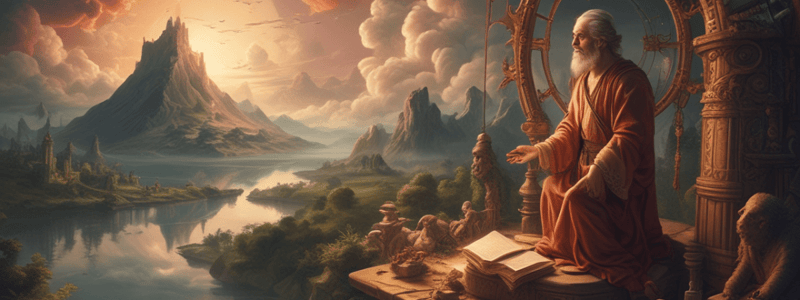Podcast
Questions and Answers
What were the three main systems of the human body according to Galen?
What were the three main systems of the human body according to Galen?
- The brain and nerves, the heart and arteries, and the liver and veins (correct)
- The brain and nerves, the heart and veins, and the liver and arteries
- The liver and nerves, the heart and veins, and the brain and arteries
- The heart and nerves, the liver and arteries, and the brain and veins
Who published De humani corporis fabrica in 1543?
Who published De humani corporis fabrica in 1543?
- Isaac Newton
- Rene Descartes
- Francis Bacon
- Andreas Vesalius (correct)
What was the contribution of Pierre Fauchard to the development of sciences?
What was the contribution of Pierre Fauchard to the development of sciences?
- He developed the scientific method
- He laid the foundations of anatomy as a science
- He laid the foundations of dentistry as a science (correct)
- He described the functioning of the circulatory system
What is the main characteristic of the scientific method?
What is the main characteristic of the scientific method?
Who defended the inductive method in the generation of knowledge?
Who defended the inductive method in the generation of knowledge?
What was the main contribution of the Scientific Revolution to the Enlightenment?
What was the main contribution of the Scientific Revolution to the Enlightenment?
What was the main limitation of scientific advances during the Middle Ages?
What was the main limitation of scientific advances during the Middle Ages?
Who published Principia in 1687?
Who published Principia in 1687?
What was the consequence of many scientists' discoveries during the Scientific Revolution?
What was the consequence of many scientists' discoveries during the Scientific Revolution?
Who described the functioning of the circulatory system?
Who described the functioning of the circulatory system?
Flashcards are hidden until you start studying
Study Notes
The Scientific Revolution and the Enlightenment
- During the Middle Ages and much of the Modern Age, the Catholic Church controlled science and the generation of new knowledge, limiting inventions and prohibiting the diffusion of knowledge that could compromise the faith.
- The Scientific Revolution emerged in the 16th century, marking a change in the way of thinking, focusing on observation, experimentation, and reason.
- In 1543, Nicolaus Copernicus published his Heliocentric model, claiming the Sun was the center of the universe, contradicting the Church's claim that the Earth was the center.
Astronomical Inventions of the Scientific Revolution
- Copernicus' Heliocentric Theory stated that the Earth and other planets revolved around the Sun.
- Galileo Galilei and Johannes Kepler reinforced Copernicus' theory through astronomical observations and mathematical calculations.
- Kepler formulated the Laws of Motion, describing the path of planets around the Sun, supporting the Copernican theory.
- Galileo Galilei contributed to the development of the modern telescope, observing the Moon and Jupiter, and discovering Jupiter's moons.
Developments in Physics During the Scientific Revolution
- Isaac Newton formulated the Laws of Motion, which are the base of classical mechanics.
- Newton formulated the Law of Universal Gravitation, explaining phenomena like comet trajectories and tides.
- Newton discovered that the shape of the Earth was spherical, with flattening at the poles.
- Willebrord Snellius postulated Snell's Law, which talks about the refraction of light.
- William Gilbert created the scientific field of electricity.
- Stephen Gray demonstrated the ability of metals to conduct electricity in 1729.
Mathematics in the Scientific Revolution
- Rene Descartes and Pierre de Fermat developed Analytic Geometry, studying geometric figures and their properties.
- Isaac Newton and Gottfried Wilhelm Leibniz laid the foundations for integral and differential calculus.
- Pierre de Fermat created the Theory of Numbers or Superior Arithmetic, studying numbers, their properties, and operations.
- Pierre de Fermat and Blaise Pascal laid the foundations of the Theory of Probability and Combinatorics.
Progress in Biology During the Scientific Revolution
- Andreas Vesalius published De humani corporis fabrica in 1543, accurately describing the human body and refuting Galen's model.
- William Harvey accurately described the circulatory system and its function in 1628.
- Pierre Fauchard laid the foundations of dentistry as a science.
The Scientific Method
- The Scientific Method was developed during the Scientific Revolution, involving observation, hypothesis, experimentation, and confirmation or refutation of the hypothesis.
- Francis Bacon published Novum organum in 1620, presenting the steps of his method for generating knowledge.
- Rene Descartes published "Discourse on Method" in 1637, describing his rules for correct scientific research.
- Isaac Newton published the Principia in 1687, laying the foundations for many sciences.
How Did the Scientific Revolution Influence the Enlightenment?
- The Scientific Revolution contributed to the Enlightenment by encouraging exploration, experimentation, and the development of new knowledge.
- The scientific method led to discoveries contrary to the interests and principles of the Catholic Church, questioning its authority and power.
- The Enlightenment questioned the absolute power of kings and the Catholic Church, separating science from theology and philosophy.
Studying That Suits You
Use AI to generate personalized quizzes and flashcards to suit your learning preferences.




